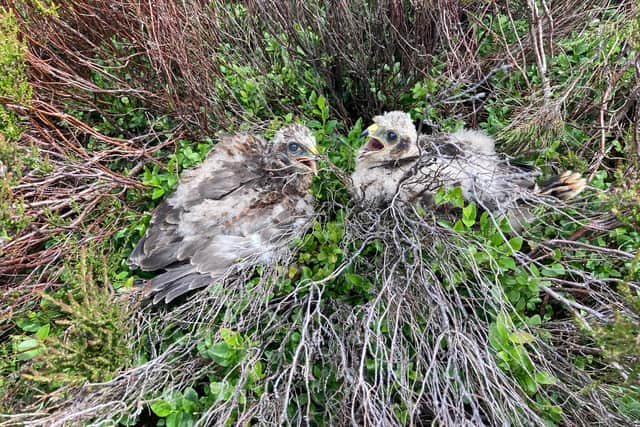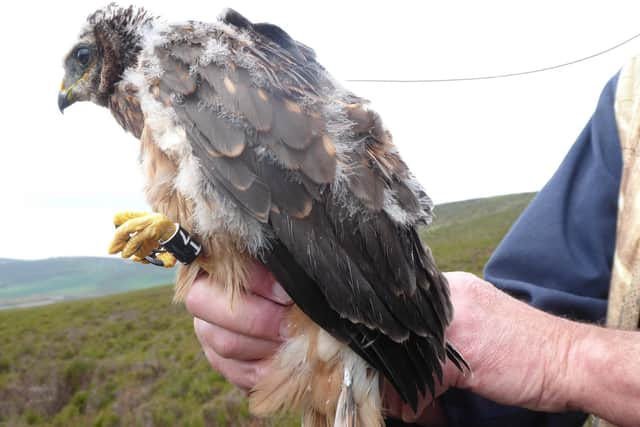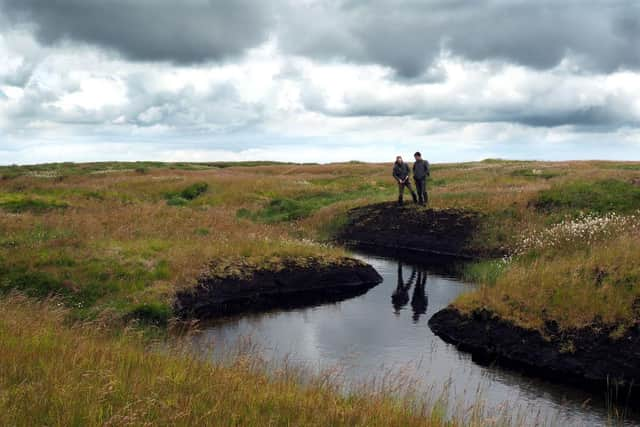Conservationists celebrate successful hen harrier nest on High Peak Moors
and live on Freeview channel 276
Hen harriers are one of Britain’s most threatened birds and lots of work has been done to support their recovery in the Peak District, but it is only the fifth time successful breeding has been recorded on National Trust land.
Jon Stewart, the organisation’s general manager for the Peak District, said: “We were delighted to learn of this nest. The hen harrier has been one of the most persecuted birds of prey in Britain for many years and we have set out on a mission to work with others to create the conditions for the harrier and other birds of prey to thrive once again in the uplands.
Advertisement
Hide AdAdvertisement
Hide Ad“Healthy bird of prey populations are at the heart of the vision we have for our land in the High Peak and in recent years the results are overall encouraging. We hope this will be a beacon of light for improving the fate of our birds of prey and providing the healthy natural environment that so many people care about and want to see.”


The National Trust has worked closely with the RSPB and the Peak District Raptor Monitoring Group to support the monitoring and satellite tagging of the young chicks.
Over the coming months, they plan to share the progress and journey of one of the birds that has been named Maia, after the Greek goddess of springtime.
Howard Jones, from the RSPB, said: “We are delighted to hear that Maia and her siblings have successfully fledged the nest in the Peak District. It is always with a mixture of joy and trepidation that we watch young hen harriers like these venture out into the wider world, as the threat of them being illegally killed once they leave the nest sadly remains.
Advertisement
Hide Ad“Satellite tagging continues to prove persecution to be the number one factor supressing the hen harrier population in England.”
Advertisement
Hide Ad

Hen harriers are famed for the adult’s mesmerising and dramatic ‘sky dance’, which the male performs as it seeks to attract a female, but their natural habitat of open areas with low vegetation has brought them into historic conflict with the grouse-shooting industry.
The species had been pushed to the point of extinction as a breeding bird on mainland Britain by 1900, and today it estimated there are only 545 breeding pairs in the country.
But this week the Moorland Association group of landowners and managers reported a record-breaking year of 24 successful nests on moorland in Northumberland, North Yorkshire, County Durham, Cumbria, and Lancashire, including at least 77 chicks.
Advertisement
Hide AdThat was up from 19 successful nests in 2020, which was itself a record-breaking year for Hen Harrier breeding on grouse moors.


Amanda Anderson, director of the Moorland Association, said: “This is another excellent year for hen harrier breeding and the wonderful pictures and footage we are seeing from our members’ moors is truly heartening. Three good years in a row shows that we have the right strategy to help the population to recover to a sustainable level, occupying a much greater area of England.
Advertisement
Hide Ad“The management carried out on grouse moors by gamekeepers provides an ideal habitat for birds of prey, with fewer predators to steal their eggs, and good numbers of prey species such as small mammals and other birds. We will continue to support initiatives that are delivering results for the UK’s Hen Harrier population.”
The National Trust published its High Peak Moors Vision in 2013, setting out its ambitions to restore help birds of prey and other threatened wildlife populations to thrive, and involve people in the care of the moors.
Advertisement
Hide AdThe conservation charity leases much of its High Peak moorland for grouse shooting and all shooting tenants have signed up to actively support the plan.
Over the last few years as well as the hen harrier, there has been breeding success for other species in and around the National Trust’s moors such as the peregrine falcon, merlin, buzzard, goshawk and short eared owl.
Jon said: “A few years ago success felt like young harriers fledging on our land. Sadly in 2019 two satellite tagged young harriers raised on the High Peak Moors, we called Arthur and Octavia, stopped transmitting suddenly not long after they had left National Trust land.
Advertisement
Hide Ad“This illustrates how fragile the recovery is of this precious bird of prey. We want to see uplands richer in wildlife and beauty, widely enjoyed and providing huge public benefits. Given the trials that face them now that they have fledged from their nesting site, we need to think of ultimate success being when these young and many more like them come back to the Peak District as adults to successfully raise young themselves.”
Advertisement
Hide AdHe added: “We have worked with our partners and tenants to give the birds the best chance of success. We have also worked with the RSPB and specialists on satellite tagging the young chicks so that we can monitor movements and learn more to inform the conservation of this very special bird.
“I hugely appreciate the commitment and efforts of everyone involved and the care taken to avoid unnecessary disturbance. We’ve managed to enable these birds to successfully raise young with the minimum of fuss. There is a great sense that we all want this to work not just for these birds now, but as a symbol for the whole future direction of our uplands.”